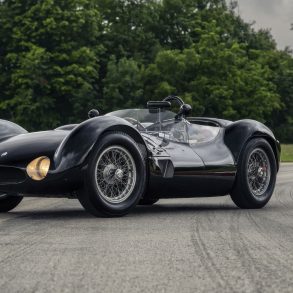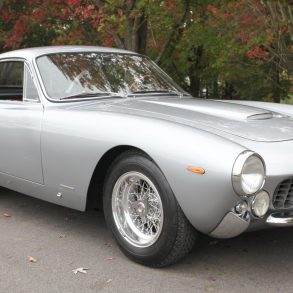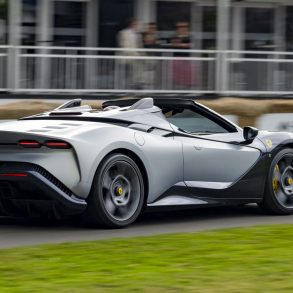
An exhibition honoring the epic Ferrari and Maserati battles opened on October 15th, 2012 at the Museo Casa Enzo Ferrari in Modena, Italy. At the inaugural “The Great Challenges-Ferrari and Maserati” display, visitors will get to see nineteen historic race cars that were selected to represent the two manufacturers and their rich racing history.
The first challenges between the Italian manufacturers took place in 1926, when the Alfa Romeo racing team, managed by Enzo Ferrari, and Maserati, which was founded a few years earlier in Bologna, faced each other for the first time on the track. After Adolfo Orsi took over Maserati in 1937, and transferred its location to Modena, where Ferrari was also located, the locale became the epicenter of the duel between the two makes.
From 1938 onwards, they competed in both style and speed, leading competition to industrious new levels. Cars with unmistakeable design and appeal, such as various GTs, the Ferrari California Scaglietti, and Vignale’s Maserati 3500, go back to this period, where the two Italian automobile giants shared prestige and traded victories.
On the evening of October 15, the new exhibition was opened in the presence of the President of the Fondazione Casa Enzo Ferrari, Mauro Tedeschini, who declared, “This is a very high level exhibition, with cars that have left their mark on the history of sports cars made in Modena.”
Some of the cars on display in the “Great Challenges-Ferrari and Maserati” exhibition include:
Maserati 250F – A Formula 1 single-seater, used between 1954 and 1960. The car was developed and outfitted under the guidance of the engineer Giulio Alfieri. It made its debut at the Argentinian Grand Prix in 1954, and won the race with Juan Manual Fangio, who also won the Belgian Grand Prix. In that same year, Stirling Moss drove a Maserati 250F the entire season. In 1956, Stirling Moss won the Monte Carlo and Italian Grand Prix at the wheel of a private 250F.
Ferrari 340MM – A race car produced by Ferrari in 1953. Only four cars were made, two with bodywork by Touring and two by Vignale. The engine was a V12 designed by Aurelio Lampredi. One of the Vignale cars had a successful debut at the 1953 Mille Miglia, driven by Giannino Marzotto and Marco Crosara. It established the average speed record for the race, which was over 142 km/h. In the same year, the car won the Giro di Sicilia with Gigi Villoresi.
Maserati Tipo 63 Birdcage – It was designed by Giulio Alfieri with a tubular lattice work chassis, which was futuristic for that time. Cars like this were lined up by the Camoradi, Sernissima, and Cunningham teams. Seeing as the results did not live up to expectations, their activity in the World Championship ended with the 4 Hours of Pescara (the last edition of the Coppa Acerbo), while the car continued successfully in some races in the United States.
Ferrari 500 TRC – A race car produced by Ferrari in 1957 in nineteen units. The model was the updated version of the 500TR, prepared so it would be in compliance with the new “Section C” of the World Championship Sport Prototypes rules. In those years, Maserati dominated many races and Ferrari decided to develop this kind of engine further, until they arrived at the 500TR, designed by Vittorio Jano. The tubular chassis was in steel, while the bodywork, an aluminium two-seater spider, was designed by Scaglietti. Gaetano Starrabba and Franco Cortese drove it in the Targa Florio in 1958 with a victory in the class up to 2000cc, and seventh place overall. The top speed reached by the 500 TRC was 245 km/h.
Maserati A6 GCS/53 – A two-seater race car produced by Maserati from 1953 to 1955. It marked the return of the alloy dual overhead camshaft , derived from the single-seater Formula 2 A6GCM. Another innovation it contained was the double starter with Marelli type distributor. The top speed was of 235 km/h. Almost all the 50 Spiders produced had Medardo Fantuzzi bodywork, three were by Vignale, Frua, and Scaglietti while Pininfarina designed the bodywork for the four coupe’ saloons, which are still in circulation today. The A6GCS/53 made its debut at the 1953 Mille Miglia, and was extremely successful in competitions. In 1953 and 1954, Luigi Musso won the Italian Championship 2 Litre Sports with the Targa Florio and the Giro di Sicilia. In 1955, Maria Teresa de Filippis came second in the Italian championship. The car also dominated international races with Luigi Musso in the Irish Tourist Trophy in 1954, Benoit Musym at the Spa-Francorchamps Circuit, and Emanuel “Toulo” de Graffenried at the Interlagos Circuit.
All of these historic cars and more are available for visitors to see in Modena. “The Great Challenges-Ferrari and Maserati” exhibition will be open to the public for six months.
For more information, visit museocasaenzoferrari.it/en.
[Source: Museo Casa Enzo Ferrari]









